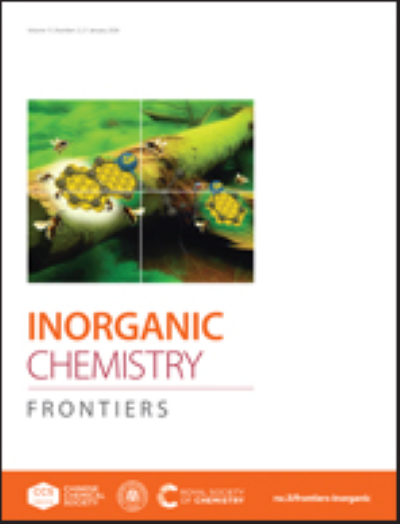通过配位结构调制实现掺杂 Sb3+ 的零维有机锡(IV)基金属卤化物在蓝光激发下的高效宽带近红外发射
IF 6.1
1区 化学
Q1 CHEMISTRY, INORGANIC & NUCLEAR
引用次数: 0
摘要
在蓝光激发下实现 Sb3+ 激活的高效宽带近红外(NIR)发射仍然是无铅金属卤化物的一个重大挑战。为了克服上述困难,我们采用配位结构调控策略,在掺杂 Sb3+ 的零维(0D)有机溴化锡(IV)中实现了蓝光激发下的宽带近红外发射。与纯(TBP)2SbBr5(TBP = 四丁基膦)在光致发光量子产率(PLQY)为 2.4% 的微弱可见光发射相比,掺杂 Sb3+ 的(TBP)2SnBr6 在 452 nm 激发下在 705 nm 处显示出高效的宽带近红外发射带,PLQY 为 33.2%,这源于自俘获激子发射。结合实验和理论计算,我们发现与基态相比,激发态晶格畸变程度大和带隙窄是 Sb3+ 掺杂(TBP)2SnBr6 在蓝光激发下产生高效近红外发射的主要原因。更特别的是,掺杂 Sb3+ 的 (TBP)2SnBr6 还具有优异的抗水稳定性,可在水中稳定存在 4 小时以上,同时保持较高的发光效率。基于掺杂 Sb3+ 的(TBP)2SnBr6 的优异稳定性和独特光学特性,我们结合商用蓝光 LED 芯片制作了一种高性能近红外发光二极管(LED),并展示了它在夜视领域的应用。本文章由计算机程序翻译,如有差异,请以英文原文为准。
Realizing Efficient Broadband Near-Infrared Emission under Blue Light Excitation in Sb3+-Doped Zero-Dimensional Organic Tin(IV)-Based Metal Halides via Coordination Structure Modulation
Realizing Sb3+-activated efficient broadband near-infrared (NIR) emission under blue light excitation remains a significant challenge in lead-free metal halides. To overcome the above difficulties, a coordination structure modulation strategy was adopted, and the broadband NIR emission under blue light excitation was achieved in Sb3+-doped zero-dimensional (0D) organic tin(IV) bromide. Compared to the weak visible light emission with a photoluminescence quantum yield (PLQY) of 2.4% for pure (TBP)2SbBr5 (TBP = Tetrabutylphosphonium), Sb3+-doped (TBP)2SnBr6 exhibits efficient broadband NIR emission band at 705 nm with PLQY of 33.2% upon 452 nm excitation, which stems from self-trapped exciton emission. Combined with experiments and theoretical calculations, we find that the large excited-state lattice distortion degree compared to the ground state and the narrow bandgap are dominant reasons for Sb3+-doped (TBP)2SnBr6 shows efficient NIR emission under blue light excitation. More particularly, Sb3+-doped (TBP)2SnBr6 also has excellent anti-water stability, existing stably in water for more than 4 hours while maintaining high luminous efficiency. Based on the excellent stability and unique optical properties of Sb3+-doped (TBP)2SnBr6, a high-performance NIR light-emitting diode (LED) was fabricated by combining a commercial blue LED chip, and its application in night vision was demonstrated.
求助全文
通过发布文献求助,成功后即可免费获取论文全文。
去求助
来源期刊

Inorganic Chemistry Frontiers
CHEMISTRY, INORGANIC & NUCLEAR-
CiteScore
10.40
自引率
7.10%
发文量
587
审稿时长
1.2 months
期刊介绍:
The international, high quality journal for interdisciplinary research between inorganic chemistry and related subjects
 求助内容:
求助内容: 应助结果提醒方式:
应助结果提醒方式:


